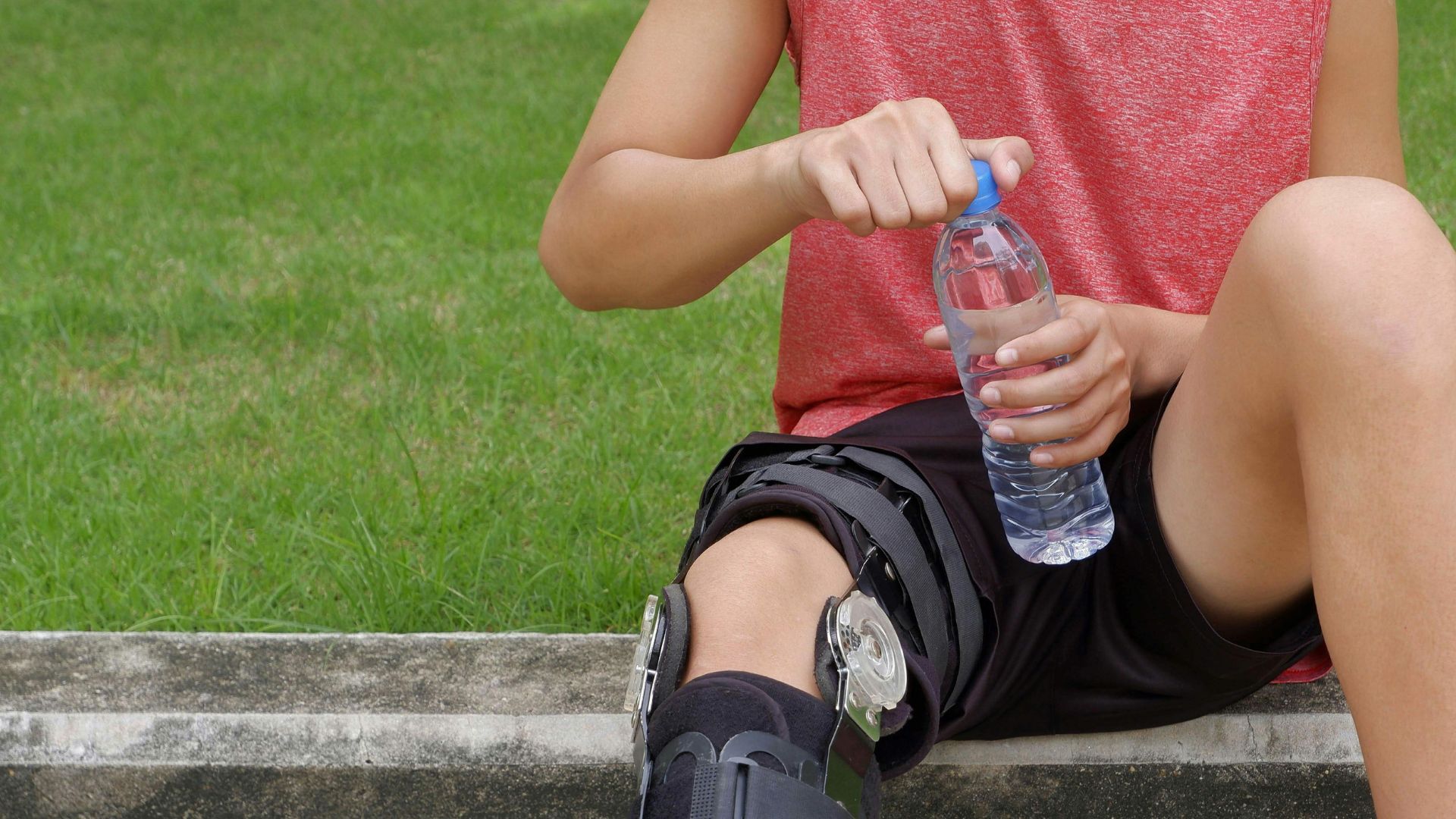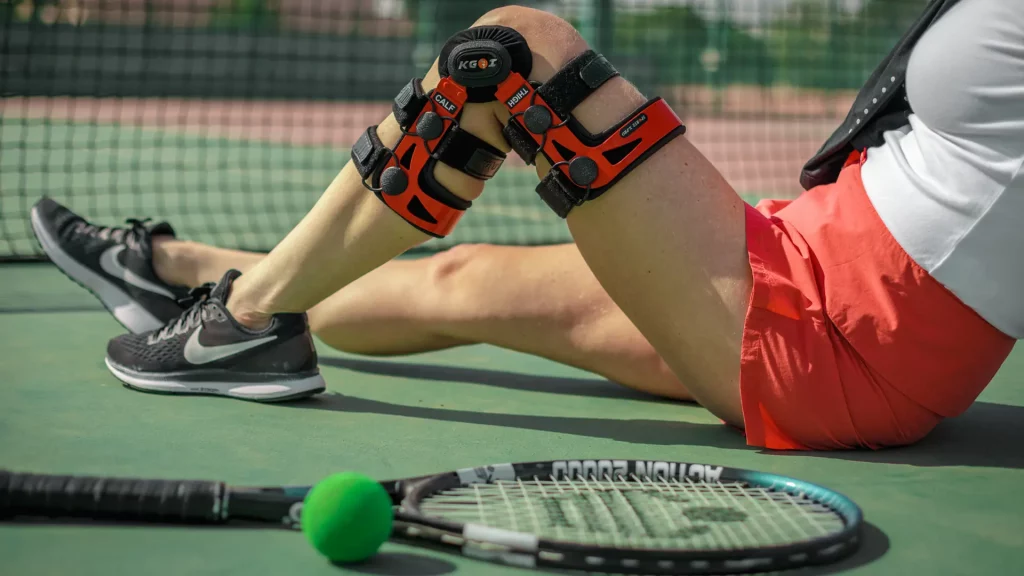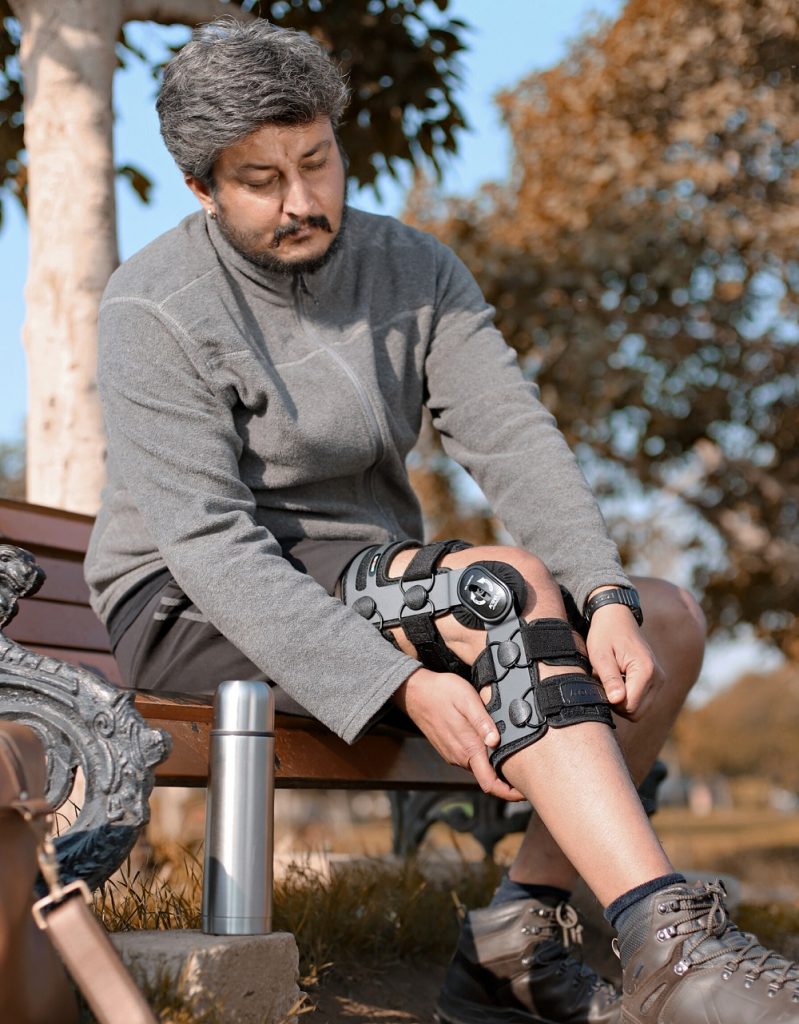Knee pain can quickly transform simple steps into towering hurdles. The promise of the right knee braces shines like a beacon, offering not just support and stability for those navigating the rocky path of injury recovery or seeking solace from arthritis but also hope.
Through our combined journey in orthopedic support, we’ve gathered valuable insights on how critical proper usage of knee stabilizers is—whether you’re looking to bounce back from a sports injury or manage the daily grind with chronic conditions like arthritis.
Our knowledge comes wrapped in understanding and empathy, ready to guide you through the dos and don’t of knee braces, ensuring you latch onto every benefit while steering clear of common mistakes.
Stick around as we unfold essential guidelines and friendly tips that make all the difference.
Key Takeaways
- Choose the right type of knee brace for your specific needs, making sure it fits properly and offers the correct support without being too tight.
- Wear knee braces as part of a broader treatment plan including physical therapy to strengthen muscles and improve knee health without over-relying on the brace.
- Regularly clean and check your knee brace for wear and tear to ensure it continues to provide adequate support and replace it when needed.
Understanding Knee Braces
Knee braces offer support for our knees. They come in different types, each serving a unique purpose for stability and pain relief.
Definition and types of knee braces
Knee braces provide support and stability for those dealing with knee pain, injuries, or conditions like arthritis. We categorize them into two main types: functional and non-functional braces.
Functional knee braces aim to improve joint stability during activities such as sports or daily movements. Non-functional knee braces focus on rest, recovery, and rehabilitation rather than exercise or sleep.
Various designs cater to specific needs. For example, we have knee immobilizers that restrict movement post-injury and knee splints that offer adjustable support. Some are tailored for athletic purposes while others are meant for everyday use.
Selecting the correct type of brace is essential to manage symptoms effectively and promote healing in a personalized manner. This understanding leads us to explore when it’s appropriate to use a knee brace in our daily routines.
How they work
Knee braces work by providing support, stability, and compression to the knee joint. They help reduce pain and prevent further injury during movement or activity. This is especially beneficial for individuals experiencing joint pain or recovering from a knee injury.
We typically wear non-functional knee braces when resting or rehabilitating rather than while exercising or sleeping.
The design of knee braces varies based on their intended use. Some are made specifically for sports, while others cater to everyday activities. Each type offers different levels of support tailored to individual needs.
Through our experiences, we have seen that wearing a brace can aid in managing symptoms related to arthritis as well, contributing significantly to overall joint protection and stability.
Wearing a knee brace does not replace proper rehabilitation methods like physical therapy. It’s crucial that we combine these supports with exercises designed to strengthen our knees and surrounding muscles.
Balancing rest with gradual movement prevents the risk of muscle weakening, which could increase the chance of reinjury over time.
When to Use a Knee Brace
Knee braces help in different situations. They support injuries, medical conditions, and recovery from surgery.
Injuries and medical conditions that may require a knee brace
Injuries and certain medical conditions often require the use of knee braces for effective support. Conditions like arthritis can lead to knee pain relief through the stability provided by these orthopedic devices.
Individuals recovering from knee injuries may also benefit significantly from this added support during rehabilitation. A non-functional knee brace is particularly useful for rest and recovery, though it should not be worn while exercising or sleeping, except when dealing with chronic issues or severe pain.
Choosing the appropriate type of knee brace is essential based on individual needs. Some braces focus on providing joint stability for sports injury prevention, while others are geared toward everyday movement.
We find that following proper guidelines enables optimal effectiveness in managing symptoms and preventing further injury. Balancing rest with gradual activity ensures we do not weaken surrounding muscles, which could increase our risk of reinjury later on.
How to choose the right type
Selecting the right type of knee brace is crucial for effective support and recovery. We should first consider our specific needs based on any existing injuries or medical conditions.
Some braces are designed for general stability, while others cater to specific activities like sports or daily movement. It’s essential to match the design with our intended use, ensuring that we choose a brace that offers adequate knee support without restricting necessary motion.
Understanding the different types of knee braces helps us make informed decisions. Non-functional knee braces focus on rest, recovery, and rehabilitation rather than exercise or sleep.
Wearing one during sleep is common among individuals dealing with arthritis or post-injury recovery; it provides extra support during those vulnerable hours. Consulting healthcare professionals can clarify which type suits us best while also addressing any concerns about proper fit and effectiveness in managing symptoms related to arthritis or previous injuries.
Do’s for Wearing a Knee Brace
We need to ensure the knee brace fits properly. A good fit offers support without causing discomfort.
Proper fit and positioning
Proper fit and positioning play a crucial role in the effectiveness of knee braces. A well-fitted brace provides optimal knee stability, helping to manage symptoms for arthritis patients and ensuring support during daily activities or sports.
We should ensure the brace aligns correctly with our kneecap for proper joint function. This alignment minimizes discomfort while promoting rehabilitation. It is essential to adjust straps securely but not too tight, as excessive pressure can lead to irritation and restrict blood flow.
Positioning should also take into account our specific needs. Some knee braces are designed for particular activities, such as athletic gear for sports or orthopedic braces for everyday movement.
Choosing the right type allows us to focus on injury prevention, recovery, and overall comfort. Following these guidelines ensures we maximize benefits from wearing a knee brace while maintaining muscle strength through appropriate use rather than excessive rest.
Gradual use and adjustment
Gradual use and adjustment of a knee brace is crucial for effective support. Starting with short periods of wear helps us get accustomed to the device without overwhelming our joints or muscles.
We should listen to our bodies, increasing wear time as we feel more comfortable. This approach aids in building the knee joint stability essential for recovery.
Holding onto a strict timeline during this adjustment phase can be counterproductive. It’s common to experience discomfort initially, but pushing through excessive pain may lead to further injury.
Knee rehabilitation emphasizes careful integration with physical therapy exercises that strengthen surrounding muscles while using the brace. Regular adjustments help us avoid overuse injuries and ensure optimal performance from our chosen orthotic devices for arthritis relief or injury management.
Don’t for Wearing a Knee Brace
Avoid using the brace too much. This can weaken your knee over time. Don’t ignore other treatments like physical therapy. These methods help support recovery and strength.
Overuse and reliance
Overusing a knee brace can lead to reliance that ultimately weakens the supporting muscles. Too much rest, while tempting during recovery, may increase the risk of reinjury. Knee braces are supportive tools but should not replace proper rehabilitation and exercise routines.
We must remember that they significantly ease pain and offer stability, yet we still need to strengthen our knees and surrounding muscles through physical therapy.
Neglecting other treatment methods is another risk associated with prolonged use of knee braces. They provide valuable support for conditions like arthritis or injuries. However, using them as a crutch rather than part of an overall treatment plan can hinder long-term recovery.
Instead of solely depending on these devices, we should continue engaging in appropriate exercises to promote healing and prevent future injuries effectively.
Neglecting other forms of treatment
Relying solely on a knee brace can lead to significant issues. Knee braces provide support and can help manage symptoms for conditions like arthritis, but they should not replace other treatments.
Engaging in physical therapy is crucial for strengthening the knee and surrounding muscles. A brace alone won’t build muscle strength or flexibility, which are vital for long-term recovery.
We must be cautious about overusing a knee brace during our rehabilitation process. Excessive reliance may weaken our muscles, increasing the risk of reinjury as we recover from an injury or manage chronic pain.
Balancing the use of a knee brace with exercise and appropriate therapies ensures that we address the underlying issues effectively while promoting healing and preventing further injuries.
Tips for Maximizing the Benefits of Knee Braces
Using a knee brace with physical therapy can improve recovery. Regularly checking and replacing your brace ensures it stays effective.
Combining with physical therapy
Combining knee braces with physical therapy can enhance recovery and rehabilitation. Knee braces provide support, reduce pain, and help manage symptoms for those with injuries or arthritis.
Physical therapy focuses on strengthening the muscles around the knee and improving mobility. Together, these approaches create a comprehensive plan for healing.
Balance is essential; too much rest can weaken our muscles, increasing the risk of reinjury. We should not rely solely on knee braces but incorporate exercises recommended by healthcare professionals to ensure a complete recovery.
This combination aids in functional improvements while ensuring we take proactive steps towards knee injury prevention and long-term health.
Proper maintenance and replacement
Proper maintenance of knee braces is essential for their effectiveness and longevity. Regular cleaning prevents skin irritation and infections caused by bacteria found in sweat. We should ensure to clean our knee braces according to the manufacturer’s instructions, using mild soap and water.
This simple step can significantly enhance hygiene, especially if the brace is worn during physical activities or sports.
Replacement of old or damaged knee braces is equally crucial. Wearing a compromised brace can lead to inadequate support, reducing its intended benefits for conditions like knee arthritis support or recovery after an injury.
It’s important to monitor the condition of our braces regularly and replace them as needed to maintain optimal function. Keeping these practices in mind helps us maximize the benefits we get from our rehabilitation equipment while supporting effective recovery strategies.
Next, we will explore how combining knee braces with physical therapy can further enhance our rehabilitation journey.
Conclusion
Addressing knee health with braces can significantly enhance our recovery journey. We discussed essential dos, like ensuring a proper fit and gradually using the brace, to maximize support and comfort.
Equally important are the don’ts; over-reliance on these devices can weaken our muscles and extend recovery time. How can we incorporate physical therapy along with wearing a brace for optimal results? Exploring additional resources or consulting healthcare professionals will deepen our understanding of effective knee management strategies.
Taking proactive steps today may lead to stronger knees tomorrow. Let’s embrace these practices together for better joint health!
FAQs
1. What are the do’s and don’t when using knee braces for recovery?
The dos include wearing your brace as directed by your doctor, adjusting it regularly to ensure a proper fit, and cleaning it often. The don’ts involve not relying solely on the brace for support but also using aids like a crutch or cane if needed.
2. How can a knee brace assist in my knee recovery process?
A knee brace provides stability and support during the healing process after an injury or surgery. It helps control pain and reduce swelling while allowing you to move safely.
3. When should I use other aids such as a crutch or cane along with my knee braces?
You should use additional supports like a crutch or cane when advised by your healthcare provider, especially during the early stages of recovery where weight-bearing may be restricted.
4. Can I adjust my own knee braces during recovery?
Yes, but only to ensure comfort and correct fitting. Avoid making major adjustments without consulting your healthcare provider first.





